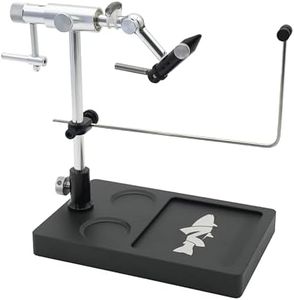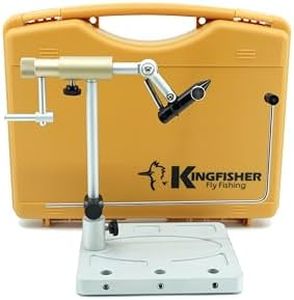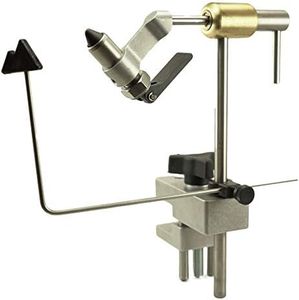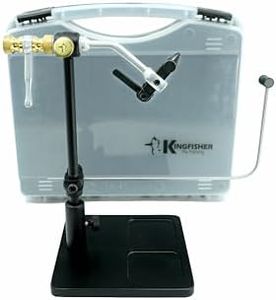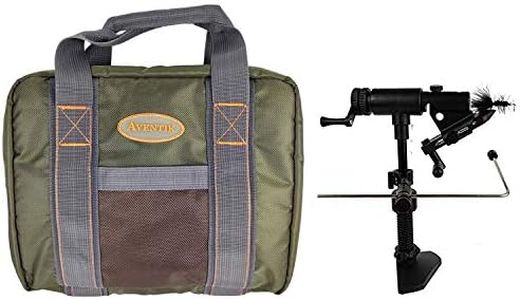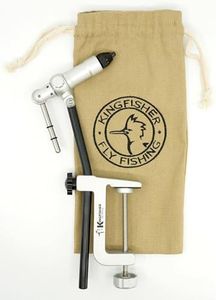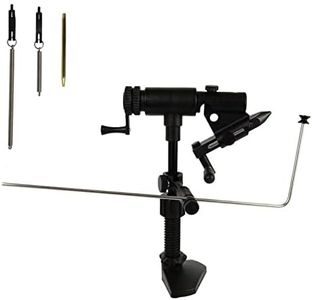We Use CookiesWe use cookies to enhance the security, performance,
functionality and for analytical and promotional activities. By continuing to browse this site you
are agreeing to our privacy policy
10 Best Fly Tying Vises
From leading brands and best sellers available on the web.Buying Guide for the Best Fly Tying Vises
Choosing the right fly-tying vise can make a world of difference in your fly-tying experience. The vise is the foundation of your setup, holding your hook securely as you tie flies. It's important to get a vise that matches your tying style and the types of flies you want to create. When evaluating vises, focus on how they hold hooks, how easy they are to adjust, and how comfortable they are to use for long periods. Knowing what you need in terms of size, portability, and features will help you make a confident decision.Jaw Design and Hook Holding CapacityThe jaws of a vise are what actually grip the hook. A good jaw design securely holds hooks without slipping or damaging them. Vises typically specify the range of hook sizes they can accommodate, often from very small (size 32) to large (size 2/0 or bigger). If you tie only small trout flies, look for a vise that excels with tiny hooks. If you plan to tie larger saltwater or bass flies, make sure the vise handles those sizes. Think about the range of flies you most want to tie—your vise should match this range so it can hold the appropriate hooks solidly.
Vise Type: Rotary or FixedThere are two main types of vises: rotary and fixed. Rotary vises allow the hook to rotate 360 degrees, which can make tying easier and more precise, especially when wrapping materials evenly. Fixed vises do not spin the hook but still hold it solidly for traditional tying. If you like detailed, symmetrical patterns or want the option to wrap materials with a spinning motion, rotary vises are great. If you’re just starting out or only tie simple flies, a fixed vise may be easier and less complex to use.
Clamping Method: C-Clamp or Pedestal BaseFly-tying vises are typically attached to your work area with either a C-clamp or a pedestal base. A C-clamp vise attaches directly to the edge of a table, offering great stability and saving space. A pedestal base vise stands on its own, making it more portable and easy to set up anywhere, even if you don’t have a suitable table edge. Consider where you’ll be tying: if your work surface is not clamp-friendly or you plan to move the vise a lot, a pedestal base is likely best. For a more permanent setup, a C-clamp can offer rock-solid support.
Adjustability and ErgonomicsAdjustability refers to how easy it is to position your vise for comfortable tying. Some vises allow you to adjust the height, angle, and even the rotation tension. This makes tying more ergonomic and helps fight fatigue over longer sessions. When considering adjustability, think about your own comfort and whether you’ll want to tweak the vise for different tying situations. If you value comfort and versatility, look for a vise with lots of adjustment options.
Build Quality and MaterialsThe materials used in a vise affect its durability and longevity. Look for vises made of high-quality metals like stainless steel or brass, as these are corrosion-resistant and built to last. Cheaper vises often use lower-quality metals or plastic, which may wear out or break over time. If you plan to tie flies regularly for years to come, prioritize vises with sturdy materials and solid construction.

